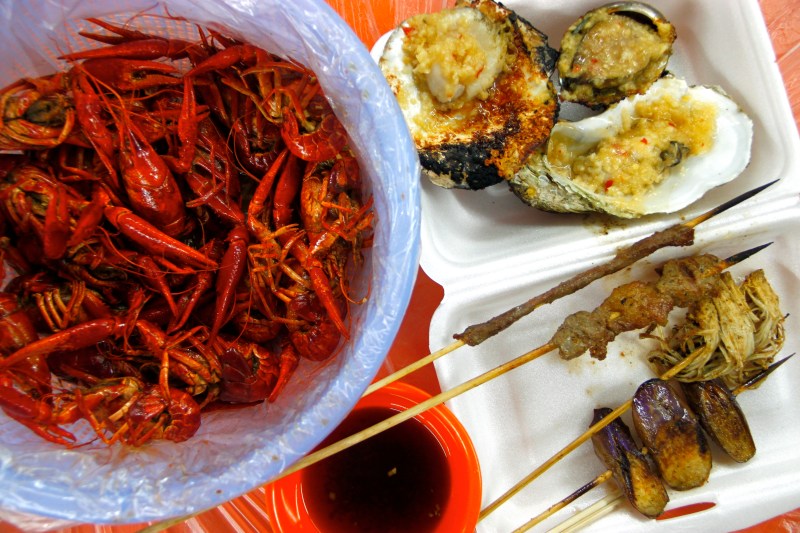One evening during the summer — in an attempt to reassure my parents that sending their youngest son off to a private university in California was indeed a worthy investment — I showed my mom and dad some photos I had taken over the course of my freshman year.
Scrolling through the photos, we came upon a picture of my birthday dim sum dinner, and my dad casually pointed out that my friends all looked (and I quote) “rather oddly coloured.” Initially dismissing it as his usual old-person casual racism, I took a closer look at the photo — only to find that my friends’ faces did, indeed, all have an odd ashen cast. I was in the midst of trying to figure out what was wrong with the restaurant lighting when I noticed the platter of kung pao pig intestines on the table.

In my defence, it was my birthday dinner, they did ask me to order whatever I wanted, and I had been craving chitterlings. I grew up eating them, after all — not to mention the fact that, other than a couple of vehement protests that I may or may not have heard, there were clearly no objections to my ordering it.
In retrospect, I suppose, the horrified looks around the table as I munched on the elastic chunks of meat were somewhat ominous portents of my friends’ squeamishness.
But this all got me thinking about the differing cultural standards people hold with food. Growing up in Singapore, a hypermodern cosmopolis in the heart of Asia, I have always been exposed to all manners of food — everything from exotic tropical fruits to dubious traditional remedies (frog ovary soup, anyone?). In particular, the all-pervading Chinese philosophy of waste not, want not has created a rich cuisine featuring every edible part of the animal — hence my platter of pig intestines.
And it’s not just Asia, either. Last spring, on a lazy weekend hike in the Santa Cruz foothills with Nadeem Hussain ’90, a professor of philosophy, and his wife, Pauline, we got to discussing the gastronomic gulf between her native Lyon — home to 22 Michelin stars — and America. In the French city, she said, bouchons dishing up offal are dime-a-dozen, whereas in most parts of le nouveau monde one would be hard-pressed to find any dish even vaguely resembling an animal part. “You see,” she whispered conspiratorially, “it’s almost like Americans are terrified of their food.”
Clearly one man’s meat is another man’s pink slime, as demonstrated by the mass hysteria that swept across the nation last year over the media’s expose on “lean finely textured beef” in ground meat. The bulk of the public’s spluttering discontent — or, dare we say, their beef — was the fact that this product is made by centrifugally removing fat from beef trimmings, which often contain cartilage and ligaments.
“Cartilage and ligaments?” What are cartilage and ligaments doing in my food? How dare they add parts of a cow’s meat into other parts of a cow’s meat?! Squeamishness reared its pristine, perfectly-marbled wagyu head as the country was divided over a Barbie-pink paste that had been going into their Big Macs. Meanwhile, the French were still roasting their os à möelle, the Italians braising their trippa alla romana, and the Hong Kongers simmering their beef tendon soup — as they had been doing for the past millennia or so.
Now, while we at Weekend don’t necessarily condone the use of pink slime — mislabelling is a particularly problematic issue in the food industry — maybe the shock and horror that arose is symptomatic of a people too far removed from its roots as an agrarian society. Perhaps, amidst the pampered privilege of having cling-wrapped, Styrofoam-boxed meats on supermarket shelves, we have become uncomfortable with the idea that our steak once mooed, of which something as visceral as pink slime is an intrusive reminder.
But a little adventurousness never harmed anybody, and maybe we would all do well to expand our culinary horizons beyond just rib-eyes and tenderloins. I mean, if you were an animal being slaughtered, you’d want every last bit of you to be used, right? In his cookbook “Nose to Tail Eating,” Ferguson Henderson famously wrote: “If you’re going to kill the animal, it seems only polite to use the whole thing.”
Perhaps it is time we try to stop being so queasy about what we eat and open up our minds — and taste buds — to unfamiliar foods. This Silicon Valley Restaurant Week, why not venture out and pick something on the menu that you’ve never seen before? Yucca mash, kumatoes, Rocky Mountain oysters: It’s a whole new world of unfamiliar dishes that could well become your next go-to hangover food.
And then, maybe — just maybe — you’ll finally be able to stomach the thought of eating kung pao pig intestines.
